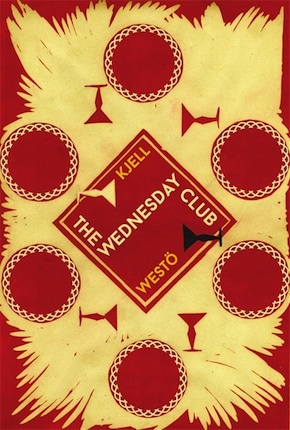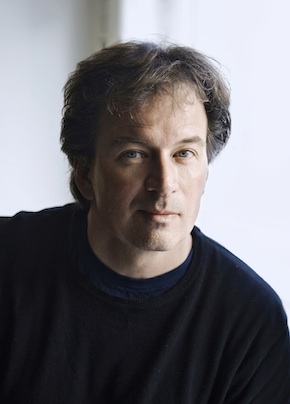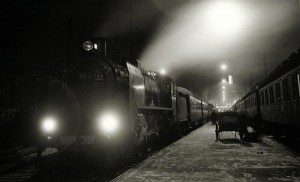A mirage of horrors
by Mika Provata-Carlone
“The Nordic region’s most important interpreter of the grand themes of our political history.” Sveriges Radio
“Our language lacks words to express this offence, the demolition of a man.” Primo Levi
The question of how one writes, thinks or speaks about the holocaust and the ideologies and sociohistorical conditions that spawned it, is perhaps as vital now as it was in the direct aftermath of a period when the word ‘hell’ could arguably be said to have lost all meaning.
Then it was a question of breaking the silence, of holding on to the faith, Paul Celan’s and Nelly Sachs’ faith, the conviction of Habermas, Levinas, Primo Levi and Elie Wiesel, Benjamin and Franz Wefel, that words could provide if not full-fledged hope, then at least release from the nightmare, a dialectic for a recovery of ethics, humaneness, sanity, historical reconstruction and possibility. Now, any investigation or reflection about that all-devouring maelstrom of history echoes our critically precarious relationship to memory, empathy, cross-national fellowship, our dire need for what Paul Shapiro, director of the Centre for Advanced Holocaust Studies, has called “an international standard for what is evil” in a world where we find it so very difficult to define what is good.
Theodor Adorno famously juxtaposed the pragmatic reality of aesthetics with the devastation of morality and ethics after WWII: “to write poetry after Auschwitz is barbaric”. His “principle of anxiety”, as he explained some years later, was that “when even genocide becomes cultural property in committed literature, it becomes easier to continue complying with the culture that gave rise to the murder” and that “the so-called artistic rendering of the naked physical pain of those who were beaten down with rifle butts contains, however distantly, the possibility that pleasure can be squeezed from it.” Imre Kertész’s own despair was that “the survivors watch helplessly as their only real possessions are done away with: authentic experiences”, while Primo Levi resolutely pointed to the festering wound of our times, the tragedy inherent in our duty of memory: “Perhaps one cannot, what is more one must not, understand what happened, because to understand… is almost to justify… No normal human being will ever be able to identify with Hitler, Himmler, Goebbels, Eichmann, and endless others. This dismays us, and at the same time gives us a sense of relief, because perhaps it is desirable that their words (and also, unfortunately, their deeds) cannot be comprehensible to us. They are non-human words and deeds, really counter-human… If understanding is impossible, knowing is imperative, because what happened could happen again.”
Echoing these concerns, impulses, imperatives and injunctions, Kjell Westö gives us in The Wednesday Club an ingenious, chilling prism through which to look afresh at the time before Nazi terror and fascist ineluctability were the panopticon of both Realpolitik and philosophy; he comes up with a visceral narrative of how naturalised the progression to total evil can be when people and society are fragments of themselves, yearning for a future without a past and for a present without weight or consequences – only pleasure, power, gratification, smooth, intoxicating modernity.
Newly independent Finland is a startling microcosm of everything that has happened and is about to happen across Europe.”
In 1938 Helsinki is a model European city, a Scandinavian Vienna where Mitteleuropa architecture coexists with starkly ambitious radical innovation like the brand-new Olympic stadium. Where time travels on many different planes: one of memory and excruciating, forced oblivion, another of Nordic glory and Russian domination, and yet a third of fast prosperity and long-drawn poverty. Newly independent Finland is a startling microcosm of everything that has happened and is about to happen across Europe. Barely recovered from a vicious and bloody civil war, it becomes the foil that foretells and already experiences the unspeakable abyss of WWII and its aftermath.
Westö gives us history through fiction and reality through ‘mirage’ – the original Swedish title of the novel. He provides us with eight or so central characters, whose lives become emblematic of every possible spiritual, social, private and physical experience, of every ethical choice and philosophical viewpoint. The Wednesday Club is an informal group of six friends, the perfect balance, we are told, of four liberals and two conservatives: two doctors, one lawyer-cum-journalist and diplomat, one sports journalist, one highly successful financier and one penniless Jew, of fragile and artistic temperament. Claes Thune, the lawyer, is the catalyst or the bond between all the disparate elements, a successful failure and a realist with a distinctly heightened degree of human empathy. He has recently hired a secretary of unquestioned skill and possibly a questionable past, Mrs Matilda Milja Alexandra Wiik, who lives as many lives and possesses as many layers of consciousness as she does names (Alexandra alone is mute). She also has a brother, a jazz musician of fractious temper, rickety finances and dark childhood traumas. As Westö has said, his characters “slowly break into smaller and smaller pieces” and we witness the process in exactly the way a forensic investigator picks up the evidence of a possible crime. We are constantly fed information –and suspended in our understanding, reason or judgement, as red herrings prove to be true signs and facts dissolve into figments.
The Wednesday Club replicates a real historical group, the Lördagssällskapet (Saturday Society), formed around university professors and students in mid-nineteenth century Helsinki. That society’s purpose was to define a culture and a literature which would be distinctly Finnish, even if Swedish linguistically. The Wednesday Club has similar aspirations: to be a nucleus of national and social unity, intellectual engagement and political discussion (with a necessary component of manly camaraderie and drinking) for the most representative members of post-internecine Finland.
The club has principles as well as opinions, a fervent responsiveness to international developments and to events at home. Through their discussions, Westö gives us current European history from the clashing perspectives of the perpetrator, the targeted victims, the self-justifying bystanders. Echoes and rumours become headlines and personal agendas on every side, political actions and figures acquire a reality that has an almost reeling quality and urgency. Between the monthly meetings of the club, life happens, and that ordinary or simply quotidian life becomes a howling echo of what has already and not yet happened. Our consciences are probed and prodded by hints of the collision between Whites and Reds, the starvation camps, the executions and deportations – of the Reds by the Whites at the end of the civil war. The left-wing political detainees don’t know where they are being taken, but “they had heard rumours that small groups of prisoners who had been told they were going home had disappeared without a trace” – a story repeated across the country, as we learn from Milja Matilda, reluctantly and painfully remembering her past.
The next exposure to history is a conversation between Claes Thune and Joachim ‘Yodi’ Jary. The Jewish member of the Wednesday Club suffers, according to his doctor, also one of the group of friends, from delusions of persecution, from an undefinable and uncontrollable anxiety. Jary shows Thune a photograph, a blurred snapshot: four men and one woman are on their knees overseen by “a group of large men in uniform” and surrounded by village onlookers. The figures on their knees, Jary explains, are Jews scrubbing a village street with toothbrushes. The “village is every village… but it happens to be in Austria” – the Anschluss or Heimkehr (homecoming) has just happened, the Austrians are to vote ‘democratically’ on whether they would like to be reunited with Germany, and the process, its ethics, credibility and repercussions had been the subject of the first club meeting described in the novel.
Thune is the typical European man of reason who sees individual events rather than patterns of behaviour and lines of destiny – or webs of heinousness. The sense of double vision that Westö achieves through this superimposition of Finnish past and holocaust future is terrifying, the most effective jagged edge to cut through any complacent analysis of the holocaust, of Nazism, or any totalitarian paradigm as a singular phenomenon of monstrousness. It has always been there already, in Finland’s Far Right movements which developed with the same volubility and demolishing proactivity as their numerous counterparts in every other European nation.
There was silent approval of the violence or an unwillingness or indifference to express disapproval by many on the right of Finnish politics – like Claes Thune, they preferred to judge “people and their fates… case by case”, refusing to believe in the existence of evil “in the biblical or in any other metaphysical sense.” That includes believing in the existence of evil on a programmatic scale, in the potential for acts of destruction that defy any definition of humanity or life. For Jary, Thune is too naïve; an advocate of Count Coudenhove-Kalergi’s pan-Europeanism, for which he will be accused as a traitor to the nation and physically assaulted by unnamed bullies.
Westö uses three central and rapidly unravelling narrative threads (the failing marriage of Thune, the mental breakdown of Jary, the onslaught of memory that will take over Mrs Wiik’s sense of reason and reality) to raise terrible questions, to create a sense of disintegration on every level: the psychological, private and historical worlds are crumbling irreversibly. Unless we can separate “a patriotic sense of morality” from hatred, racism of any kind, including anti-Semitism; unless we can properly attune instinct with civilisation, culture with nature; unless we distinguish sharp clarity from master-race determinism and “weak humaneness” from the power to obliterate and the will to rule. In an effort to reconnect the fragments, Thune writes an article on the state of Europe that concludes with the assertion that “Nationalism and tribal thinking are tenacious sicknesses. They are best treated with reading and travel.”
The Wednesday Club is a tense, gripping thriller… an examination of the conditions that render possible an ideology of evil, a rhetoric of hatred.”
Like Dante, Thune is seeking a star to lead him away from the insularity and ignorance he diagnoses as two of the primary causes. There are constant references to stars in the novel, through the prefix or suffix stjerna, countless allusions to Scandinavian poets and writers, to a cultural tradition which would be as familiar a recollection for Finnish readers as it is a riveting journey of discovery for anyone unfamiliar with it. For Westö this is a way to both provide a solid anchor and compass to Thune’s suspended existence, and also to ask the question that is most difficult concerning the holocaust, any form of genocide and mass violence: how was it possible when so many alternatives existed?
The Wednesday Club is a tense, gripping thriller, a cosmos of many lives clamouring for a voice, echoing Celan’s despair that “if I couldn’t have written, I wouldn’t have survived… my metaphors are my wound.” It is an examination of the conditions that render possible an ideology of evil, a rhetoric of hatred, the constitutional naturalisation of horror and sadism, the entitlement, no less, to violence. Westö constantly plays with familiarisation and defamiliarisation, with the obscurity of a little known (or little acknowledged) Finnish past and the sense that this slowly revealed muted darkness, under the civilised surface of modernity, is a doppelgänger to another black terror and horror, to events and acts that happened with a similar naturalising sequence and process: a Nazi Germany that has become perhaps (as Adorno had feared) overly familiar and has lost its savage feel of truth and reality. By unravelling and mystifying at the same time the everyday and the individual, its precarious balance and thin façade, Westö forces us to look again, to imagine the images of both past and present, visualise the shadows of the future, Nelly Sachs’ “sign in the sand” but also the footprints of monsters.
Most poignantly, The Wednesday Club probes into the nature of guilt, sin and innocence, asks us to consider what is the discourse of survival – and if there is one. Only 22 members of the Jewish community in Finland perished during WWII, whereas thousands of Reds (and Whites) perished as a result of the civil war. Westö places equal emphasis on the single Jewish character and his story as he does on Mrs Wiik, whose half-told story in the starvation camps prefigures the stories of millions elsewhere. He uses the exceptional victim (in Finland at least) and the bearer of historical consequences as a mirror to our own indifference, lack of empathy, sharing of suffering. Mrs Wiik tried to forget and proceed with life – a partial, dissimulated life that compromised all sense of pain and identity. She is brutally forced to remember when she recognises one of the Wednesday Club members as the Captain who had raped her repeatedly at the camp. The cat-and-mouse game that ensues, the failed attempts to trust and hope underscore the terrible repetition of patterns of a humanity turned monster. By transposing a narrative about Nazism and anti-Semitism on a different – awfully similar – historical past, Westö manages to create a powerful narrative of authentic experience and of vital clarity, a book one cannot put down or easily forget.
 Kjell Westö was born in 1961 and made his literary debut in 1986, since publishing poetry, short stories and novels. His five great novels set in his home town Helsinki in the twentieth century have established him as a leading name among today’s Swedish-language writers in Finland. His international breakthrough came in 2006 with the novel Där vi en gang gått (Where Once We Walked), which was translated into most major European languages and for which he was awarded the Finlandia Prize, Finland’s most prestigious literary award. The Wednesday Club, translated by Neil Smith, is published by MacLehose Press in hardback and eBook. Read more.
Kjell Westö was born in 1961 and made his literary debut in 1986, since publishing poetry, short stories and novels. His five great novels set in his home town Helsinki in the twentieth century have established him as a leading name among today’s Swedish-language writers in Finland. His international breakthrough came in 2006 with the novel Där vi en gang gått (Where Once We Walked), which was translated into most major European languages and for which he was awarded the Finlandia Prize, Finland’s most prestigious literary award. The Wednesday Club, translated by Neil Smith, is published by MacLehose Press in hardback and eBook. Read more.
Author portrait © Cata Portin
Neil Smith is the translator of Liza Marklund’s bestselling Annika Bengtzon crime series, as well as working on Postcard Killers, the novel she co-wrote with James Patterson. He has also translated books by Hjalmar Bergman, Marie Hermanson, Mons Kallentoft, Anders de la Motte, Leif G.W. Persson and Alexander Söderberg.
Mika Provata-Carlone is an independent scholar, translator, editor and illustrator, and a contributing editor to Bookanista. She has a doctorate from Princeton University and lives and works in London.


